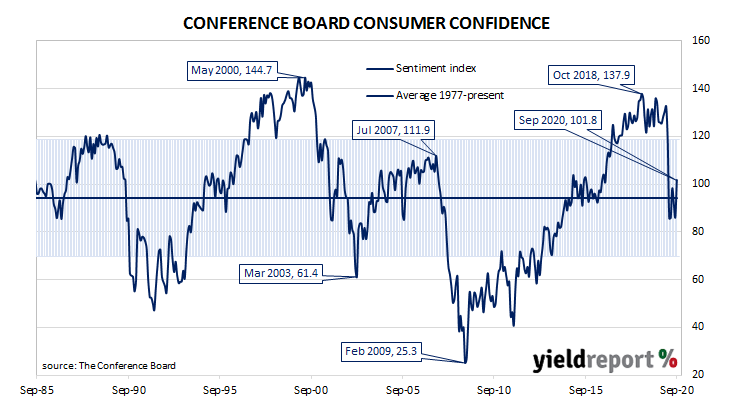Summary: US consumer confidence jumps above long-term average; view of present and future conditions both improve; “renewed optimism” in short-term outlook; rise attributed to low interest rates, jobs recovery, higher share prices; “labour market indicator consistent with sluggish recovery”.
US consumer confidence collapsed in late 2007 as the US housing bubble burst and the US economy went into recession. By 2016, it had clawed its way back to neutral and then went from strength to strength until late 2018. Measures of consumer confidence then oscillated within a fairly narrow band at historically high levels until they collapsed earlier this year.
The latest Conference Board survey held during the first half of September indicated US consumer confidence has jumped back above its long-term average. September’s Consumer Confidence Index registered 101.8, well above the median consensus figure of 90 and considerably higher than August’s final figure of 86.3. Consumers’ views of present conditions and of future conditions both improved significantly from those held at the time of the August survey.
“A more favourable view of current business and labour market conditions, coupled with renewed optimism about the short-term outlook, helped spur this month’s rebound in confidence. Consumers also expressed greater optimism about their short-term financial prospects…” said Lynn Franco, a senior director at The Conference Board.

Longer-term US Treasury bond yields reacted in a mixed fashion. By the end of the day, the 2-year Treasury bond yield had added 2bps to 0.14%, the 10-year yield had slipped 1bp to 0.65% while the 30-year yield finished unchanged at 1.41%.
In terms of US Fed policy, expectations of any change in the federal funds rate over the next 12 months retained a slight easing bias. OIS contracts for November implied an effective federal funds rate of 0.076%, about 1.5bps below the current spot rate.

